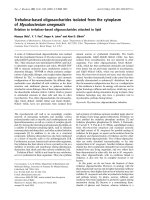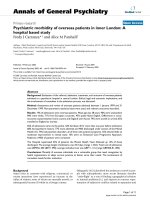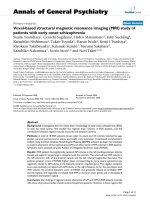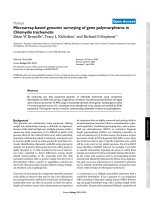Báo cáo y học: "Scenario based outdoor simulation in pre-hospital trauma care using a simple mannequin model" ppsx
Bạn đang xem bản rút gọn của tài liệu. Xem và tải ngay bản đầy đủ của tài liệu tại đây (344.28 KB, 6 trang )
ORIGINAL RESEARCH Open Access
Scenario based outdoor simulation in pre-hospital
trauma care using a simple mannequin model
Per P Bredmose, Karel Habig, Gareth Davies, Gareth Grier, David J Lockey
*
Abstract
Introduction: We describe a system of scenario-based training using simple mannequins under realistic
circumstances for the training of pre-hospital care providers.
Methods: A simple intubatable mannequin or student volunteers are used together with a training version of the
equipment used on a routine basis by the pre- hospital care team (doctor + paramedic).
Training is conducted outdoors at the base location all year round. The scenarios are led by scenario facilitators
who are predominantly senior physicians. Their role is to brief the training team and guide the scenario, results of
patient assessment and the simulated resp onses to interventio ns and treatment. Pilots, fire-fighters and medical
students are utilised in scenarios to enhance realism by taking up roles as bystanders, additional ambulance staff
and police. These scenario participants are briefed and introduced to the scene in a realistic manner. After comple-
tion of the scenario, the training team would usually be invited to prepare and deliver a hospital handover as they
would in a real mission. A formal structured debrief then takes place.
Results: This training method tech nique has been used for the training of all London Helicopter Emergency
Medical Service (London HEMS) doctors and parame dics over the last 24 months. Informal participant feedback
suggests that this is a very useful teaching method, both for improving motor skills, critical decision-making, scene
management and team interaction. Although formal assessment of this technique has not yet taken place we
describe how this type of training is conducted in a busy operational pre-hospital trauma service.
Discussion: The teaching and maintenance of pre-hospital care skills is essential to an effective pre-hospital trauma
care system. Simple mannequin based scenario training is feasible on a day-to-day basis and has the advantages of
low cost, rapid set up and turn around. The scope of scenarios is limited only by the imagination of the trainer s.
Significant effort is made to put the participants into “the Zone” - the psychological mindset, where they believe
they are in a realistic setting and treating a real patient, so that they gain the most from each teaching session.
The me thod can be used for learning new skills, communication and leadership as well as maintaining existing
skills.
Conclusion: The method described is a low technology, low cost alternative to high technology simulation which
may provide a useful adjunct to delivering effective training when properly prepared and delivered. We find this
useful for both induction and regular training of pre-hospital trauma care providers.
Introduction
Delivering effective critical care to patients suffering
major traumatic injury in the pre-hospital e nvironment
is highly demanding. Clinicians must be able to rapidly
assess both the “scene” and their patients, utilize a vari-
ety of critical interventions and be able to operate
effectively in stressful and sometimes hazardous envir-
onments. To ensure the highest possible standard of
care clinicians must develop a large number of skills
and competencies and practise them frequently to main-
tain clinical efficacy. To achieve these aims London
Helicopter Emerg ency Medi cal Servi ce (Londo n HEMS)
is involved in extensive training and assessment of doc-
tors and paramedics in pre-hospital trauma care. “Sim-
ple mannequin” simulation using low cost equipment
forms a vital part of that training.
* Correspondence:
London Helicopter Emergency Medical Service, Department of Pre-h ospital
Care, The Royal London Hospital, London E1 1BB, UK
Bredmose et al. Scandinavian Journal of Trauma, Resuscitation and Emergency Medicine 2010, 18:13
/>© 2010 Bredmose et al; licensee BioMed Central Ltd. This is an Open Access article distributed under the terms of the Creative
Commons Attribution License ( which permits unrestrict ed use, distribution, and
reproduction in any medium, provided the original work is properly cited.
The effectiveness of training clinical skills in a simula-
tor has been described as early as 1969 [1] and the feasi-
bility of such training has been documented in a variety
of fields [2]. In-hospital scenario based learning is well
established [3]. T he aim of this paper is to describe a
simple method of training which can be easily integrated
into the daily routine of a pre-ho spital service, without
prohibitive cost. Previously there has been a focus on
high-fidelity simulation in pre-hospital care as documen-
ted by Batchelder et al [4].
In this paper we focus is on “simple mannequin”
simulation with an emphasis on “psychological and
environmental fidelity” as a means of pre-hospi tal train-
ing. We describe the preparation, scenario design and
process of simulation as well as suggestions to maximize
the effectiveness of training.
Definition of “Simple Mannequin” Simulation
“Simple” mannequin simulation refers to the use of
mannequins without features like advanced vital signs or
programmed response simulation (commonly referred to
as high fidelity simulators). Commonly a vailable simple
mannequin models include the Laerdal Resuscitation
Anne, Ultimate Hurt, Crash Kelly and AmbuMan.
Requirements for a “simple mannequin” are shown in
Additional file 1.
Background
The London Helicopter Emergency Medical Service
(HEMS) provides a doctor/paramedic team response to
major trauma patient s in an urban area. The population
covered is up to ten million and the service has attended
over 21,000 calls since its inception in 1988. Callouts are
specifically targeted to patients suffering major t rauma
via specific despatch criteria and the service aims to
prov ide a large range of critical care skills to patients as
early as possible following their injury. The scope of
pre-hospital management includes extrication, advanced
splinting and haemorrhage control, anaesthesia and
sedation and a variety of cardiothorac ic procedures
including pre-hospital clamshell thoracotomy. Training
of staff involves mastering a large body of required read-
ing and equipment and a four week “sign-off” period of
mentoring with senior clinicians prior to independent
practice. “Simple mannequin” simulation forms a vital
part of this training, which we describe below.
Aims of Simulation
“Simple mannequin” simulation directly facilitates the
acquisition and retenti on of a large range of skills and
competencies including but not limited to:
1. Rapid familiarization with equipment and medical
packs
2. Enabling practice of critical skills such as rapid
sequence intubation
3. Developing crew resource management skills and
effective team work between staff
4. Practicing unusual or difficult clinical scenarios
such as complicated extrication, multiple patient
incidents and unsafe scenes
5. Simula tion of rare events such as equipment fail-
ure or failed airway protocols
Scenarios are also designed to train and familiarize
crews with the equipment that is used less frequently
and uncommon but challenging clinical scenarios. They
aim to maintain and develop skills and mental prepara-
tion for those less common eventualities.
Method of “Simple Mannequin” Simulation Scenario
Development
The scope and number of scenarios are limited only by
the imagination of the scenario facilitator but it is
important to plan each scenario carefully. All facilita tors
are experienced pre-hospital care physicians. The initia-
tors for this form of training have all had previous
experience with simulation. As the system evolved more
facilitators were edu cated. Most doctors and paramedics
who join th e service have been involved with facilitating
simulation before. This facilitator education takes place
within the organisation, and consists of talk-through,
formal teaching and then leading scenarios supervised
by experienced facilitators. The debrief after a scenario
always ends with feedback to the facilitator which
ensures continuous development of both the simulation
as well as each individual facilitator. Planning begins
with setting the particular skills, competencies and
events which are to be tested. It is important to limit
the focus of each scenario to a few key learning points
to provide appropriate emphasis, although some skills
such as scene safety assessment, situational awareness,
teamwork and crew resource management will be prac-
ticed in almo st all team based simulatio ns. A realistic
mechanism of injury and environmental setting he lp to
maximise immersion in the scenarios for the partici-
pants. A mental flowchart of mannequin responses to
interventions ( or failure to intervene) based on realistic
physiology m ust be developed and used by the scenario
facilitator to guide the scenario. If possible it is benefi-
cial to utilize ancillary staff for bystander and external
roles and at HEMS London pilots, fire-crew and medical
students are routinely used to provide simulated roles
such as ambulance crew, police, bystanders and even
press. These additional roles provide an important level
of realism and test difficult crew resource management
issues. There is a great opportunity for bystanders to
learn whilst contributing to the training.
Bredmose et al. Scandinavian Journal of Trauma, Resuscitation and Emergency Medicine 2010, 18:13
/>Page 2 of 6
Preparation
Equipment should be identical to that used in daily
operations and prepared and checked as for a real mis-
sion. HEMS London uses a clearly marked “training
pack” of medical equipment with non-sterile reused dis-
posables to reduce the waste of expensive consumables
but which are otherwise indistinguishable from daily
operating packs. The mannequin is placed in a position
appropriate to the scenario, utilizing realistic obstruc-
tions or space limitations. Nearby obstructions can be
used to make the scenario scene more realistic for parti-
cipants (Figu re 1). Role playing assistants are brie fed on
the patient, their injuries and the aims of the scenario
and take up their positions. The team is briefed with a
realistic “call out” message and pre-hospital mission
information as they would on a normal mission. They
are then allowed to access the patient.
Procedure
On arrival at the simulated scene additional briefing is
given regarding the scene and age, sex and appearance
of the patient. A verbal handover to the HEMS team of
the patient’s relevant immediate assessment is given by
the on-scene role-playing ambulance crew. The scenario
facilitator guides the progress of th e scenario. Through-
out the assessment and management of the patient the
scenario facilitator constantly updates the patient status
and reports the results of monitoring. Results of inter-
ventions are relayed if not immediately simulated on the
mannequin. To maintain immersion it is vital that the
doctor/paramedic being train ed constantly checks the
mannequin and monitor for assessment of vital signs
and response rather than directly conversing with the
scenario facilitator. At the conclusion of the scenario a
simulated verbal handover to the receiving hospital is
assessed.
“Rules of the Game”
• All assessments should refer to the mannequin
rather than conversing with the scenario facilitator.
For example assessment of breath sounds should
involve simulated auscultation with a stethosco pe
with the results announced by the scenario facilitator
rather than asking the scenario facilitator “what do I
hear when I listen to the chest?”
• All procedures should be performed or simulated
where possible. This requires the training crew to
remove the equipment from the packs and proceed
as far as possible into the procedure i.e. iv access
means use of tournique t, tape/securing the access
properly and fluid attachment.
• Lapses or errors should be treated in a realistic
fashion. For example, failure to adequately secur e a
simulated intravenous cannula should result in inad-
vertent removal.
• The scenario facilitator controls the tempo and
progress of the scenario to keep the participants in
“the Zone” and tailors the scenario to the partici-
pants’ performance.
The “Zone”
The “Zone” refers to the psychological state of simulated
realism and immersion that is essential for effective pre-
hospital trauma training. The aim is for the training
team to believe they are treating a real patient and
experience a realistic level of stress. It is achieved by the
careful choice and construction of the scenario and by
effective guidance of the scenario by the scenario facili-
tator. The scenario facilitator uses the simulated physio-
logical parameters of the mannequin to direct the need
for interventions and determines success or failure of
such interventions. The facilitator must remain ahead of
Figure 1 Local and nearby obstructions are used to create a simulation-scene for i.e. entrapment or road traffic collisions with
entrapment. Using closeby (on the helipad) obstructions makes it feasible to train with the on-call crew. The imagination and creativity of the
facilitator and other staff is important for creating a scene that takes the participant into “the zone”.
Bredmose et al. Scandinavian Journal of Trauma, Resuscitation and Emergency Medicine 2010, 18:13
/>Page 3 of 6
the scenario and the simulated responses. The impor-
tance of m aintaining “The Zone” is constantly empha-
sized to our scenario facilitators. We believe this
facilitates eff ective learning and is a significant focus of
all our training scenarios to ensure that trainees “forget”
they are treating a mannequin and experience a high
level of psychological fidelity.
Debrief
All scenarios benefit from immediate debriefs which are
structured and guided by a check sheet which is based
on one used to debrief real training missions (Additional
file 2). Debr ief ing is essenti al to maxi mize learning out-
comes. It helps identify erroneous decision making or
crew resource management issues and to enables the
scenario facilitator to reinforce key learning points.
Observers, medical students and no n-medical partici-
pants all take part in the structured debrief, which is
lead by the scenario facilitator. After the formal struc-
tured debrief of the participan ts is completed, there is a
formal feedback to the scenario facilitator of their run-
ning of the scenario. This is important for the develop-
ment and improvement of future training and for skill
development of scenario facilitators.
Additional file 3 summarises key-poi nts for success in
implementing this form for simulation in a service.
Discussion
Simulation is the process of recreating characteristics of
the real world [5]. In general p re-hospital simulation
can be divided into part-task training, which refers to
replication of a single task or part of a complete process
and full mission training which attempts to replicate the
environment and interactions of a complex process.
Simulation mannequins can be differentiated along a
spectrum of fidelity related to the complexity of vital
signs simulation or interaction. Fidelity has been charac-
terized by Rehmann et al [6] as consisting of three
inter-related dimensions. The first dimension, equip-
ment fidelity, refers to the degree to which the simulator
replic ates the appeara nce and behaviour of the real sys-
tem. We believe that it is essential to utilise accurately
simulated operational packs and equipment. The second
dimension, environmental fidelity refers to the external
visual and sensory cues provided by the simulator. The
third and arguably the most important dimension, psy-
chological fidelity [5] refers to the degree to which the
trainees suspend disbelief and enter into the simulated
reality of the situation. This is what we refer to as “the
Zone”. Whilst high fideli ty mannequin simulators have
become popular for training in anaesthesia, emergency
medicine and advanced life support [7] there have been
no published studies which d emonstrate a direct corre-
lation between fidelity and training effectiveness [5,7].
Risser et al [8] describes how team training can reduce
the number of behavioural factors leading to clinical
errors, which is similar to our philosophy.
Wisborg et al who have founded and initiated the
BEST Foundation (Better & Systematic Trauma Care),
describes an effective method of simple training of
trauma teams in hospitals in Norway [9]. We believe the
same principles ap ply to the use of operational equip-
ment and realis tic surroundings. Our method differs in
that there is no need for our operational crew to “go
offline” and training can be performed while immedi-
ately available as part of a daily operational routine.
This makes it even more feasible and ensures that the
training is not a “one time event” [5].
Figure 2 All members of the team are expected to engage in the scenario training. It is of importance to participate and act in a realistic
manner, use gloves, use stretchers in the same was as in a real-patient situation. Involving other members of staff and using real equipment in
the scenario is important for keeping participants in the zone as well as for maintaining a high degree of realism in the scenarios.
Bredmose et al. Scandinavian Journal of Trauma, Resuscitation and Emergency Medicine 2010, 18:13
/>Page 4 of 6
Effective use of “simple” mannequin simulation
requires a greater focus on situational and psychological
fidelity requiring careful scenario development and sce-
nario facilitator involvement. This type of training may
more effectively focus training on issues such as team
interactio n, crew resource manageme nt and the goals of
training, rather than just the technological features of
the mannequin being used.
This form of training focuses on most of the factors
described in Anesthesia Crisis Resource Management
(i.e. awareness, start of treatment, allocation, declaration,
leadership and communication) [10]. These are all fac-
tors that are core skills for pre-hospital care team mem-
bers. These skills are very difficult to acquire and
demonstrate without practical training.
We use simulation for training and induction of new
staff b ut also for skills maintenance in established staff.
Within the service of London HEMS, There is a high
degree of motivation for this kind of training both
among paramedics and doctors and indeed motivation
among participants is essential to the succe ss of this
type of training [11]. This motivation is bolstered by th e
rotating nature of positions for doctors and p aramedics
and by making it a compulsory part of training and the
daily routines for the on-call crew. We believe that a
service implementing this kind of training on a regular
basis needs to establish a core of interested people to
initiate the programme and from such a foundation seek
to involve the whole organization. Figure 2 shows how
all members of the team participate and engage in the
scenario training.
Simulation is widely used [12] in medical training -
particularly in hospital operating room anaesthesia train-
ing or teaching specific types of clinical incident s e.g.
the management of arrhythmias. However the complex-
ity, cost and fragility of high fidelity and complex man-
nequin devices limits their utility in realistic outdoor
pre-hospital settings. Recently Lee et al. have shown
that there is no difference between using high- and low-
fidelity mannequins for testing of critical care skills [13].
Advantages of “Simple” Mannequin Simulation:
• Reasonable and accessible solution for any
organization
• Less risk of damage to the simulator in adverse
weather, enclosed spaces and difficult extrication
scenarios
• Minimal set-up time and rapid turn-around
• Available for use in any location away from power
supplies
• Focuses simulation on the goals of training
Conclusion
Our experience is that “simple” mannequin training
focused on realistic environments and psychological
fidelity provides an effect ive training tool for develop-
ment of skills in pre-hospital trauma care. It could be
rapidly implemented in most services with little expense
and m inimal disruption to clinical duties. It can be uti-
lized in the daily routine of operational staff and has
become an essential part of HEMS London training in
the challenging area of pre-hospital trauma care. We
hope that the description of our training model will
encourage other services to implement similar training
at their institu tions (Additional file 3) and that studies
of the effectiveness of this type of training will follow.
Additional file 1: Requirements for a “simple mannequin”.
Click here for file
[ />13-S1.DOC ]
Additional file 2: The checklist used for structured debrief after all
scenarios.
Click here for file
[ />13-S2.PDF ]
Additional file 3: These are key-points for successfully implement and
use simulationtraining in a pre-hospital care service.
Click here for file
[ />13-S3.DOC ]
Acknowledgements
The authors would like to thank all clinical staff at the London’s Air
Ambulance for contributing in developing this form for training and
teaching.
Authors’ contributions
PB and KH devolved the simulation method and drafted the manuscript, GG
developed the simulation system, DL and GD contributed in the writing
process. All authors read and approved the manuscript.
Competing interests
The authors declare that they have no competing interests.
Received: 14 July 2009 Accepted: 15 March 2010
Published: 15 March 2010
References
1. Abrahamson S, Denson JS, Wolf RM: Effectiveness of a simulator in
training anesthesiology residents. J Med Educ 1969, 44(6):515-9.
2. Draycott TJ, Crofts JF, Ash JP, Wilson LV, Yard E, Sibanda T, Whitelaw A:
Improving neonatal outcome through practical shoulder dystocia
training. Obstet Gynecol 2008, 112(1):14-20.
3. Rosenthal ME, Adachi M, Ribaudo V, Mueck JT, Schneider RF, Mayo PH:
Achieving housestaff competence in emergency airway management
using scenario based simulation training: comparison of attending vs
housestaff trainers. Chest 2006, 129(6):1453-8.
4. Batchelder AJ, Steel A, Mackenzie R, Hormis AP, Daniels TS, Holding N:
Simulation as a tool to improve the safety of pre-hospital anaesthesia–a
pilot study. Anaesthesia 2009, 64(9):978-83.
5. Beaubien JM, Baker DP: The use of simulation for training teamwork skills
in health care: how low can you go?. Qual Saf Health Care 2004, 13(Suppl
1):i51-6.
Bredmose et al. Scandinavian Journal of Trauma, Resuscitation and Emergency Medicine 2010, 18:13
/>Page 5 of 6
6. Rehman A, Mitman R, Reynolds M: A handbook of flight simulation
fidelity requirements for human factors research. Technical Report No.
DOT/FAA/CT-TN95/46 Wright-Patterson AFB, OH:Crew Systems Ergonomics
Information Analysis Center 1995.
7. Mcfetrich J: A structured literature review on the use of high fidelity
patient simulators for teaching in emergency medicine. Emerg Med J
2006, 23(7):509-11.
8. Risser DT, Rice MM, Salisbury ML, Simon R, Jay GD, Berns SD: The potential
for improved teamwork to reduce medical errors in the emergency
department. The MedTeams Research Consortium. Ann Emerg Med 1999,
34(3):373-83.
9. Wisborg T, Brattebø G, Brattebø J, Brinchmann-Hansen A: Training
multiprofessional trauma teams in Norwegian hospitals using simple
and low cost local simulations. Educ Health (Abingdon) 2006, 19(1):85-95.
10. Howard SK, Gaba DM, Fish KJ, Yang G, Sarnquist FH: Anesthesia crisis
resource management training: teaching anesthesiologists to handle
critical incidents. Aviat Space Environ Med 1992, 63(9):763-70.
11. Wisborg T, Brattebø G: Keeping the spirit high: why trauma team training
is (sometimes) implemented. Acta Anaesthesiol Scand 2008, 52(3):437-41.
12. Wisborg T, Castren M, Lippert A, Valsson F, Wallin CJ: Training trauma
teams in the Nordic countries: an overview and present status. Acta
Anaesthesiol Scand 2005, 49(7):1004-9.
13. Lee KH, Grantham H, Boyd R: Comparison of high- and low-fidelity
mannequins for clinical performance assessment. Emerg Med Australas
2008, 20(6):508-14.
doi:10.1186/1757-7241-18-13
Cite this article as: Bredmose et al.: Scenario based outdoor simulation
in pre-hospital trauma care using a simple mannequin model.
Scandinavian Journal of Trauma, Resuscitation and Emergency Medicine 2010
18:13.
Submit your next manuscript to BioMed Central
and take full advantage of:
• Convenient online submission
• Thorough peer review
• No space constraints or color figure charges
• Immediate publication on acceptance
• Inclusion in PubMed, CAS, Scopus and Google Scholar
• Research which is freely available for redistribution
Submit your manuscript at
www.biomedcentral.com/submit
Bredmose et al. Scandinavian Journal of Trauma, Resuscitation and Emergency Medicine 2010, 18:13
/>Page 6 of 6









